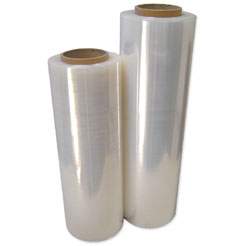 Stretch wrap is one of the most widely used packaging products on docks, in warehouses, at manufacturing facilities, and other places where products and packages are prepared for shipment.
Stretch wrap is one of the most widely used packaging products on docks, in warehouses, at manufacturing facilities, and other places where products and packages are prepared for shipment.
Plastic film is convenient for holding boxes and products together on a pallet, or preventing them from shifting or becoming damaged as they make their way through the supply chain.
But while most people are familiar with stretch wrap, they may not know that there actually are many different types of plastic packaging film, each of which has its own specific purpose and uses.
Types of Stretch Wrap
The most popular types of plastic stretch wrap include UV stretch wrap, vented pallet wrap, anti-static stretch film, and colored stretch film.
Most can be grouped into two categories: Cast stretch wrap and blown stretch wrap.
Cast stretch wrap is made using a cast extrusion process in which a thermoplastic material is melted and extruded through a flat die onto a chill roll, where it is quenched and then resolidified. This produces a more affordable type of stretch wrap with increased clarity.
Blown stretch wrap is made using a blown extrusion process in which the plastic melt is extruded through a vertical annular slit die to form a thin walled tube. Air is then blown through a hole in the center of the die to blow up the tube like a balloon. Then on the top of the tube an air ring blows onto the film to cool it down.
This produces a stretch wrap with a higher load and stretch capacity, as well as a higher degree of memory once stretched out.
Thicknesses of Stretch Wrap
Within these sub-categories, each type of stretch wrap comes in different widths and thicknesses for use in various applications.
One of the thinnest types of stretch wrap is 37 gauge, which is ideal for bundling two light uniform objects together.
Other thicknesses include 47 gauge, 60 gauge, 63 gauge, all the way up to 150 gauge, which is used when stretch wrap requires superior strength and puncture resistant properties, such as for wrapping steel, metal, and other heavy duty items.
Stretch wrap can be applied in a number of different ways. For larger, repetitive jobs, there are turntable stretch wrap machines that automatically wrap multiple loads per hour.
For simpler applications, some stretch wraps come inside packaging that includes applicators, such as cutting edges and rollers. The simplest type of stretch wrap, and one of the most widely used, simply uses a dowel or rod such as a broom handle to apply it to the packages or products that require wrapping.
